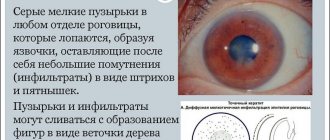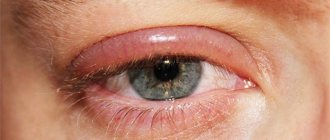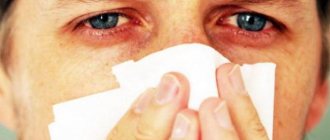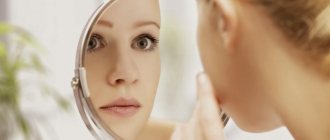What is blepharitis?
In this article
- What is blepharitis?
- Signs of the upper eyelid
- Why does blepharitis of the upper eyelid develop?
- Diagnosis of the disease
- What is the difficulty in diagnosing blepharitis of the upper eyelid?
- What types of blepharitis affect the upper eyelid?
- What is local therapy?
- Methods of etiological treatment
- Principles of restorative therapy
- Hygiene procedures for blepharitis of the upper eyelid
- Treatment with folk remedies
- Blepharitis of the upper eyelid. Treatment prognosis
Blepharitis is the Latin name for a very wide group of ophthalmological diseases. They have different symptoms, inflammations can form in different places. In most cases, blepharitis affects the edges of the eyelid. This can happen both from the outside and from the inside. Often the inflammatory process affects the meibomian glands. There are quite a few types of disease. They all differ in different pathogens, but are accompanied by largely similar symptoms.
The difficulty with blepharitis is that this disease is difficult to treat. The localization of the inflammatory process almost always develops in the ciliary edges of the eyelids. The disease has a tendency to relapse. It can last for a very long time and, as a result, become chronic. Blepharitis is quite difficult for the patient to tolerate. The disease leads to decreased performance and can often lead to decreased and even loss of vision. If discomfort occurs, it is necessary to find out the source of the discomfort and seek help from an ophthalmologist.
Why can only the lower eyelid hurt?
Important! All common diseases accompanied by pain in the eyelid are characteristic of both the upper and lower parts. In case of pain when blinking and closing the eyes, this may be a symptom of:
- Blepharitis.
- Infection with molluscum contagiosum is characterized by the appearance of small light nodules.
- Endophthalmitis - inflammation of the eye membranes.
Associated diseases:
- neuritis (nerve damage);
- canaliculitis - a disease of the tear ducts;
- Dacryocystitis is an inflammatory process in the lacrimal sac.
Signs of the upper eyelid
The inflammatory process that forms along the edges of the eyelids is blepharitis. The disease is quite common in adults and children. However, adults are predisposed to lesions of the upper eyelid. Signs of the disease become noticeable almost immediately. You shouldn't ignore them. The list of the most common symptoms includes:
- itching and burning;
- redness in the eye area;
- the occurrence of edema or swelling;
- increased visual fatigue;
- serous or purulent discharge;
- feeling of heaviness of the eyelids;
- photophobia.
In some cases, there is an increase in temperature. But it may not always be observed and depends on the state of the body’s immune system. Sometimes ophthalmologists note a thickening of the thickness of the eyelid, which indicates the “addition” of such ailments as, for example, barley, etc.
Infectious and viral causes of eyelid pain
The eyelid is a delicate organ that is at constant risk of infection.
This often occurs in the presence of microtraumas, small cracks and other damage to the skin, with reduced immunity, lack of sleep , and lack of minerals and vitamins.
Furuncle
Acute necrotic inflammation , caused by staphylococcus.
Know! It is characterized by a large painful swelling in which the rod appears. Pain and swelling can spread to half of the face or even the entire surface of the head.
Barley
Purulent inflammation that can spread to the eyelash bulb, meibomian and sebaceous glands.
The eyelid hurts, turns red, and swelling forms . The causative agent in most cases is staphylococcus.
People at risk include people who have suffered from hypothermia, vitamin deficiency, weakened immunity, or problems with the endocrine glands.
that appears becomes very red and painful , and can be small in size or occupy half of the eyelid.
General symptoms are possible: fever, headaches, and sometimes swollen lymph nodes.
The stye usually disappears on its own , often without even opening. It is unacceptable to squeeze it out or influence it in any other way.
Note! Heating or attempting to open the stye can lead to serious consequences, in particular meningitis.
Shingles
Occurs due to the penetration of the herpes virus.
The malaise is accompanied by a general deterioration of the condition and develops very sharply .
High fever is possible, spreading to the temples and forehead. Sharp pain occurs in all affected areas, a blistering rash and hyperemia may appear.
Abscess
An abscess begins as a lump that develops into a swelling with redness . The eyelid droops and soreness appears on the scalp.
Phlegmon
Keep in mind! Appears on the eyelid or in the lacrimal sac. Cellulitis of the eyelid is characterized by soreness of the eyelid and thickening, redness of the skin.
General malaise appears. The temperature rises and headaches occur.
With phlegmon of the lacrimal sac, the pain is concentrated in the inner corner of the eyelid, in this place there is swelling, redness, and a lump is palpable.
The causative agents are pyogenic microbes. Often, phlegmon develops after mechanical impact (attempts of squeezing and opening) on a stye or boil, or when an infection penetrates into the injured eyelid.
May be a complication after sinus inflammation.
Chalazion
With a chalazion, the cartilage in the area of the meibomian gland becomes inflamed and a slight hardening occurs.
When inflamed, the formation is painful; in case of a breakthrough, pus may be released .
Erysipelas
The causative agent of the disease is hemolytic staphylococcus. It penetrates through the damaged area of the skin.
The problem manifests itself suddenly and sharply , accompanied by chills and elevated body temperature.
The eyelid turns red, swells, and severe pain appears . The areas damaged by the disease are raised in the form of a small ridge; swelling separates them from healthy skin.
Why does blepharitis of the upper eyelid develop?
There can be many reasons for the development of blepharitis of the upper eyelid. The most common are infectious forms of diseases. They are caused by various groups of bacteria (Staphylococcus aureus and Staphylococcus epidermidis). The cause of the disease may also be hidden in damage to the eye by mites, for example, Demodex, or fungi. The main cause of damage to the upper eyelid is a staphylococcal infection, which damages the hair follicles of the eyelashes. The occurrence of this form of the disease is often caused by diseases such as:
- tonsillitis;
- sinusitis;
- frontal sinusitis;
- caries;
- impetigo.
In more rare cases, the “provocateurs” of blepharitis of the upper eyelid are herpes viruses types I, II and III. The cause of eye disease is often Hemophilus influenzae, molluscum contagiosum, intestinal bacteria, yeast-like fungi, etc.
Non-infectious forms of blepharitis are less common in practice. They are mainly caused by allergic pathogens. It often happens that the development of a non-infectious type of disease is associated with a lack of vision correction: myopia, farsightedness or astigmatism. Dry eye syndrome is often a concomitant illness. If a person has increased sensitivity to irritants (pollen, cosmetics and medications), then blepharitis of the upper eyelid takes on an allergic form. The occurrence and exacerbation of blepharitis of the upper eyelids is caused by:
- chronic intoxication;
- decreased immune status;
- lack of vitamins in the body;
- work in conditions of increased smoke;
- long stay in a solarium or in the sun.
Damage to the upper eyelids often occurs with contact dermatitis. Endogenous allergization of the body often occurs with gastritis, colitis, cholecystitis and other diseases of the gastrointestinal tract. An increased risk of disease occurs with helminthiasis, tuberculosis, and diabetes. Ophthalmologists have noted that in these diseases the composition of the secretion of the meibomian glands changes.
Non-infectious causes
It is worth noting! In addition to the penetration of viruses and infections into the skin, there may be other reasons: associated with other diseases of the body or injuries.
Eyelid pain can occur due to :
- burns and injuries;
- hypothermia;
- unsanitary conditions in the place of residence;
- eye fatigue, lack of sleep;
- vitamin deficiency, lack of minerals;
- excessive drinking, fluid retention;
- using low quality cosmetics;
- insect bites.
Pain, redness, swelling of the eyelid can be a signal of diseases:
- diabetes;
- gynecological problems;
- allergy.
Diagnosis of the disease
To prescribe effective treatment, the ophthalmologist must clearly identify the signs of eye damage. In some situations, an accurate diagnosis can be made after a visual examination of the patient and collection of anamnesis. Usually, in order to clarify the type of disease, the ophthalmologist prescribes the following diagnostic procedures:
- Visometry, with the help of which it is possible to check visual acuity both with and without correction. If a child gets an appointment with an ophthalmologist, this procedure also makes it possible to determine refractive error: farsightedness or astigmatism;
- Biomicroscopy. What it is? The procedure is a visual examination of the affected eye using special equipment - a slit lamp. Biomicroscopy easily helps determine the degree of swelling, redness of the edges of the eyelids, the presence of secreted serous or purulent fluid;
- Examination of the roots of eyelashes under a microscope, during which several eyelashes are taken from the patient and examined under magnification to determine mite infestation;
- Bacterial culture is an analysis that involves taking a smear from the eyelids or the scales covering them. This allows you to determine the infectious agent that provoked the development of blepharitis.
Typically, these procedures are performed in cases where the ophthalmologist suspects that the patient has infectious blepharitis. If the tests proved otherwise, the doctor will most likely advise you to consult an allergist.
What to do if your eyelid hurts?
Obviously, for such a symptom, when both the lower and upper eyelids hurt, there can be many reasons, from the most harmless to the very dangerous.
Be careful! Therefore, self-medication and trying to find out the diagnosis from all-knowing relatives and neighbors is unacceptable.
Do not heat or cool, press, open the swelling or the area of redness, or rub your eyes. You should also not use decorative cosmetics.
To relieve pain and redness, minimal interventions are acceptable
- rinse your eyes using strong tea , chamomile or calendula infusion;
- if you have allergies , take your regular antihistamines ;
- Apply antibiotic eye drops.
If the pain and swelling does not go away, you should immediately consult an ophthalmologist.
What is the difficulty in diagnosing blepharitis of the upper eyelid?
Blepharitis in the upper eyelid is more difficult to diagnose than in the lower eyelid. The difficulty in recognizing this eye disease lies in the likelihood of relapse. Some patients are confident that if they were previously diagnosed with blepharitis, then there is nothing to worry about. Therefore, many of them turn to the ophthalmologist too late and begin treatment.
Treatment for blepharitis done at home usually does not produce positive results. This is only possible in cases where treatment was started immediately when the first signs of the disease appeared. In all other cases, postponing a visit to the ophthalmologist delays treatment for blepharitis and contributes to the spread of infection throughout the body.
In extreme cases, serious complications can occur. In such situations, the patient will have to visit not only an ophthalmologist, but also a dermatologist or allergist. In later stages of the disease, cell scrapings of the eyelash epithelium may be necessary. Inflammation of the upper eyelid requires an integrated approach to treatment. It is recommended to “resort” to three leading directions: local, etiological and restorative therapy.
What types of blepharitis affect the upper eyelid?
There is a certain classification of inflammation of the upper eyelid. These include:
- Catarrhal (simple) blepharitis, which is characterized by minor hyperemia - overflow of blood vessels. The swelling is slightly pronounced;
- Squamous blepharitis, the distinguishing feature of which is an accumulation of scales. Patients may complain that their eyelashes stick together, their eyes begin to hurt from bright light;
- Ulcerative blepharitis, in which crusts form along the edges of the eyes; when they are removed, bleeding ulcers are visible. The patient may develop madarosis - complete loss of eyelashes;
- Demodectic blepharitis, caused by the Demodex mite. It can be detected using microscopic examination. The microorganism lives on the edges of the eyelashes;
- Angular blepharitis, or rosacea, is characterized by reddish purulent “nodules” that form on the eyelids;
- Allergic blepharitis, its source is an allergen, accompanied by increased lacrimation and sensitivity to light.
Blepharitis of the upper eyelid is often accompanied by signs of conjunctivitis, keratitis, and meibomitis. A chalazion or stye may develop.
What is local therapy?
Local therapy is symptomatic treatment. It includes hygiene procedures, eyelid massage, etc. For scaly blepharitis of the upper eyelid, it is imperative to wash the eyelids once a day and treat them with ointments at least 5-6 times. To do this, you can use tetracycline or albucid ointment, which your doctor will recommend. The medicine should be carefully applied with your finger to the front edge of the eye.
If a patient is diagnosed with ulcerative blepharitis of the upper eyelid, then the crusts that form on the eyelids must be removed. The easiest way to do this is after they have dried. The exposed skin surface, which has a pink tint, should be lubricated with a solution of brilliant green. Upon completion of the manipulation, it is necessary to instill any disinfectant drops.
If blepharitis of the upper eyelid occurs due to demodicosis, then massage sessions should be performed. They are performed with special sticks and only on an outpatient basis. This method of treatment is considered traumatic. Therefore, this procedure must be carried out only in a hospital. The massage is performed by a specialist. Self-sessions can be dangerous to the eyes.
Methods of etiological treatment
The principles of etiological treatment are aimed at eliminating the underlying cause of the disease. This allows you to avoid relapse of the disease in the future and its transition to the chronic stage. The most common causative agent of upper eyelid blepharitis is Staphylococcus aureus. In this case, ophthalmologists prescribe antibiotics, which allows you to “pacify” the action of pathogenic microorganisms.
The cause of blepharitis of the upper eyelid is often helminthization of the body - infection of the body with helminths. In such cases, for effective treatment, it is recommended to take antihelminthic drugs. This procedure is necessarily carried out with the subsequent neutralization of the released parasites, their fragments, larvae and eggs.
If the causative agent of the disease is fungi, then antifungal drugs - antimycotics - are prescribed. Among the drugs of this class, polyenes are considered universal. When used topically, they act on spores of fungi, unicellular organisms, and parasites. Drugs in this group have shown themselves to be effective in treating external mucous membranes and preventing relapses.
If blepharitis of the upper eyelid has been diagnosed, then increased attention is paid to its treatment. Allergic reactions often occur in women who constantly use decorative cosmetics. The components contained inside it often cause an allergic reaction. In such cases, treatment is often supplemented by consultations with an allergist and dermatologist.
Hygiene procedures for blepharitis of the upper eyelid
Blepharitis is difficult to cure if hygiene procedures are not followed. Their implementation plays an important role in the treatment and prevention of this ophthalmological disease. The main hygienic procedure is daily eye washing. It is best to use sterile dressings and exclusively boiled water for this. Medicinal infusions of chamomile, marshmallow, rose hips, thyme or calendula, which have an anti-inflammatory effect, will have a good effect.
The prepared solution should be at room temperature. This will avoid damaging the damaged skin of the eyelids. It is necessary to rinse both eyes at once, even if only the eyelid is inflamed. Individual cotton swabs or bandages should be used for each. Reuse of hygiene products is prohibited. This can lead to infection of the visual organs and cause serious complications.
Treatment
To get rid of an unpleasant disease, you cannot do without the help of an ophthalmologist. First, a consultation is necessary to make a competent and accurate diagnosis. An experienced doctor must identify the nature of the pathology and determine the reasons that provoked the development of inflammation of the eye gland in the lower eyelid. The course of treatment will depend on the results of diagnostic measures.
Only a specialist can determine how to treat inflammation of the lower eyelid in an individual case. Treatment is based on drug therapy. The main objective of the course is to eliminate the causes that provoked the development of the disease and eliminate unpleasant symptoms. Depending on the nature of the pathology, special solutions and eye drops are prescribed.
If demodicosis has been detected, medications are prescribed that are designed to eliminate mites. Basically, such drugs are prescribed in the form of ointments, which are applied to the affected eyelid before going to bed at night. The components that make up such ointments have a negative effect on the vital activity of ticks, disrupting their natural life cycle. For this reason, their harmful effect on tissue is significantly reduced.
If the inflammation is allergic in nature, the task of therapy is first of all to eliminate the irritating factor - the allergen that caused the disease. If this is not possible, treatment consists of corticosteroid-type ointments, as well as antiallergic medications.
During treatment, it is especially important to adhere to good eye hygiene. For this purpose, special cosmetics are used, which are also recommended by an ophthalmologist. If you follow all hygiene recommendations, you can get rid of the disease much faster and prevent its recurrence.
Some doctors recommend following a special diet for acute forms of the disease. In this case, the diet should mostly consist of products of plant and dairy origin. It is advisable to consume meat only in boiled form. Excessively fatty and smoked foods, as well as alcoholic drinks, can aggravate the situation and intensify the inflammatory process.
Treatment with folk remedies
It often happens that treatment for blepharitis is delayed for many months. It is highly undesirable to use medications during this period. In such situations, traditional medicine becomes a good alternative. Infusions and decoctions of medicinal herbs are usually used, for example:
- sage;
- chamomile;
- calendula;
- Kalanchoe;
- eucalyptus.
A well-proven remedy is onion decoction with the addition of boric acid. It is recommended to wash your eyes with it no more than twice a day. Propolis is considered an effective remedy. A teaspoon of crushed substance is mixed with 100 grams of Vaseline. After this, place it in an opaque container. The damaged area of the eyelid should be carefully lubricated with a thin layer of the resulting solution.
Traditional medicine is “rich” in a variety of recipes for the treatment of ophthalmological diseases. You can use various plants. It can be aloe, and drupe, and parsley. The main thing is to follow the recipe and consult with your doctor before starting to use such products.








